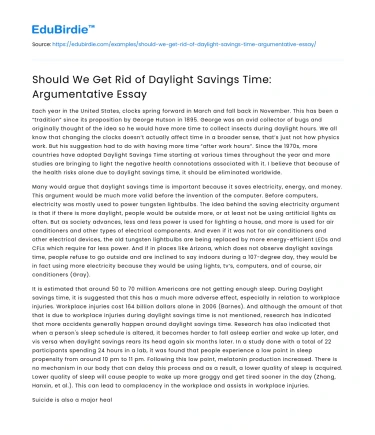Each year in the United States, clocks spring forward in March and fall back in November. This has been a “tradition” since its proposition by George Hutson in 1895. George was an avid collector of bugs and originally thought of the idea so he would have more time to collect insects during daylight hours. We all know that changing the clocks doesn’t actually affect time in a broader sense, that’s just not how physics work. But his suggestion had to do with having more time “after work hours”. Since the 1970s, more countries have adopted Daylight Savings Time starting at various times throughout the year and more studies are bringing to light the negative health connotations associated with it. I believe that because of the health risks alone due to daylight savings time, it should be eliminated worldwide.
Many would argue that daylight savings time is important because it saves electricity, energy, and money. This argument would be much more valid before the invention of the computer. Before computers, electricity was mostly used to power tungsten lightbulbs. The idea behind the saving electricity argument is that if there is more daylight, people would be outside more, or at least not be using artificial lights as often. But as society advances, less and less power is used for lighting a house, and more is used for air conditioners and other types of electrical components. And even if it was not for air conditioners and other electrical devices, the old tungsten lightbulbs are being replaced by more energy-efficient LEDs and CFLs which require far less power. And if in places like Arizona, which does not observe daylight savings time, people refuse to go outside and are inclined to say indoors during a 107-degree day, they would be in fact using more electricity because they would be using lights, tv’s, computers, and of course, air conditioners (Gray).
Save your time!
We can take care of your essay
- Proper editing and formatting
- Free revision, title page, and bibliography
- Flexible prices and money-back guarantee
It is estimated that around 50 to 70 million Americans are not getting enough sleep. During Daylight savings time, it is suggested that this has a much more adverse effect, especially in relation to workplace injuries. Workplace injuries cost 164 billion dollars alone in 2006 (Barnes). And although the amount of that that is due to workplace injuries during daylight savings time is not mentioned, research has indicated that more accidents generally happen around daylight savings time. Research has also indicated that when a person's sleep schedule is altered, it becomes harder to fall asleep earlier and wake up later, and vis versa when daylight savings rears its head again six months later. In a study done with a total of 22 participants spending 24 hours in a lab, it was found that people experience a low point in sleep propensity from around 10 pm to 11 pm. Following this low point, melatonin production increased. There is no mechanism in our body that can delay this process and as a result, a lower quality of sleep is acquired. Lower quality of sleep will cause people to wake up more groggy and get tired sooner in the day (Zhang, Hanxin, et al.). This can lead to complacency in the workplace and assists in workplace injuries.
Suicide is also a major health issue that has been tied to the first few weeks of daylight savings time. According to an article written by the Southern Illinois Labor Tribune in March of 2011, a study done in Australia found that men are more likely to commit suicide during daylight savings time (DST Can Mean More Health Issues). Suicide is a leading cause of death in the United States. And although specific death rates caused because of daylight savings are not mentioned, there are noticeable spikes around daylight savings.
Anxiety and depression are also serious considerations and potential negative connotations to Daylight Savings Time. Dr. Gary Proctor states that sleep issues often have underlying causes in and of themselves and lead to exacerbation of those underlining causes (PR Newswire US). It would go without saying that changing someone’s sleep pattern, which is done twice each year, would make depression and anxiety worse. Someone who experiences severe cases of anxiety would be more concerned about being late for a meeting for instance. Or they may be more prone to overreact if they were to be late to work because of daylight savings time, which could even cause a panic attack. The best way to negate or marginalize the effects of daylight savings time on those that suffer from anxiety and depression is to maintain a schedule and stick to it. “having a set wake-up time and trying to wind down in the evening around the same time too” (Wu).
Daylight savings time may save money and may save energy by synchronizing our active times to coincide with the lighter portions of the day during each respectable time of the year, but at what cost? Mental health issues such as suicide and insomnia are serious side effects of daylight savings time. Getting less sleep does prove a risk to others that are not as affected by daylight savings time. Those affected greatly can become complacent at work causing an accident that could potentially harm many others.
Annotated Bibliography
- Barnes, Christopher M., and David T. Wagner. “Changing to Daylight Saving Time Cuts into Sleep and Increases Workplace Injuries.”






 Stuck on your essay?
Stuck on your essay?

